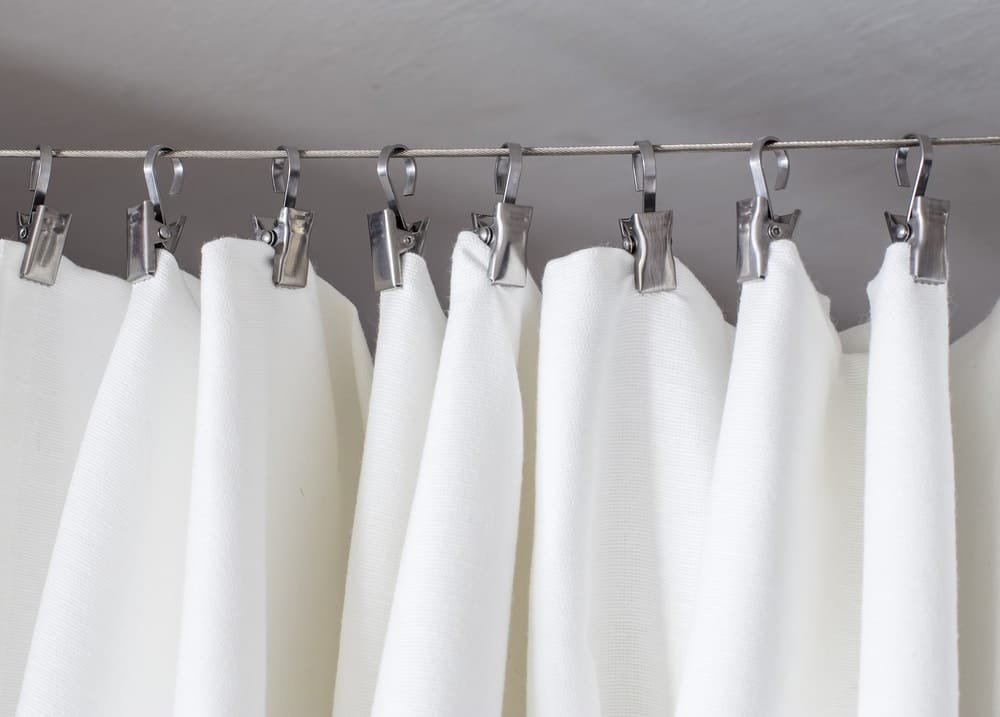The significance of shower curtains installed in our bathrooms is obvious. Despite preventing water from flooding on our bathrooms’ floor and hiding our nakedness while bathing or taking a shower, they also add elegance and style into our bathrooms. But the question of whether shower curtains should go inside our bathtubs or not has been a hot debate among many people. You could also be struggling with this issue. Luckily, this article will give insight into whether shower curtains should go inside the tub or not. You may need to continue reading for insight.
Should You Let Your Shower Curtain Go Inside Your Bathtub or Not?
It is a no-brainer; if your shower curtain goes outside the tub and gets water, it will flood on your bathroom’s floor. So what do you do to prevent this? First, consider the purpose of your shower curtain. Among other reasons, it is supposed to hide you as you bath as it enhances your bathroom’s appearance. You, therefore, cannot put it inside your tub while bathing. It will soak in water and become a perfect environment for breeding molds, mildew, and bacteria. You should try to maintain your shower curtain as dry as possible. The solution to this is installing a shower curtain liner.

Shower curtain liners get put inside the bathtub while bathing to help prevent water from flooding on the floor. At the same time, they enable you to keep your shower curtain dry and outside the tub. But maintaining these liners inside the tub can be tricky at times. Some even blow in on you, making your bathing experience very uncomfortable. But you shouldn’t worry, there are ways to help keep these shower curtain liners in their place. Are you eager to know? Then check out the following.
How Do You Secure Shower Curtain Liners in Their Place?
a. Bottom Weighted Liners
Some liners get made heavy on their underside. As a result, they don’t get blown or swung around the tub while you bath. They stick to their position until you finish bathing or taking a shower.
b. Heavyweight Liners
Though heavyweight liners come at an extra cost, they are sturdy and don’t sway around when inserted in the bathtub.
c. Installing Curved Shower Curtain Rods
A curved or bent shower curtain rod keeps the liner much further away from the shower water. As a result, the liner does not get drawn in easily and stays at its position.
d. Using Binder Clips, Magnets, or Suction Cups

You need not worry if your bathroom has no tub around the shower to put binder clips or stick-on magnets. You can use the suction cups. To all sides of the shower opening, place a suction cup directly onto your shower wall. Getting these suction cups should not bother you as they get easily found in most home improvement stores near you. Then clip binder clips on to your shower curtain liner, near the suction cup. When you then enter into the shower, force the binder clip’s wire loop around the suction cup’s nub to help secure the curtain. But because there are shower curtain liners made with magnets, it could be easier buying them than getting to go through all this.
But you may ask; what if I don’t want a shower curtain liner in my bathroom, what do I do? No need to worry, there are shower curtains designed for different showers and bathtubs. They also come in various colors, sizes, and get made with different materials. Most importantly, they get designed to fit all your bathroom needs. You may need to install these shower curtains to fit your aging needs, suit a particular person like one using a wheelchair, or optimize your shower space or bathtub. In this case, you should know the exact shower curtain to buy. To help you in getting the right shower curtain or liner, check out the following insight into various shower curtains available on the market today.
What are the Various Shower Curtain Types Available on the Market Today?
1. Curbless Showers
Curbless showers, also known as the roll-in or thresholdless showers comes without a threshold between the bathroom floor and the shower stall. It becomes ideal for anyone on a wheeled mobility device like a wheelchair or walker. The person can enter and exit the bathroom with ease. Unfortunately, containing water in the shower stall becomes hard. Luckily, there are shower curtains explicitly designed for such bathrooms. Such shower curtains are heavy and hang along. But while buying these shower curtains, you should consider the following factors.
· Length
Consider a shower curtain that will almost graze the shower floor. But you should be careful not to touch the ground as it can develop mildew. Consider how that shower curtain will get attached to the shower curtain rod. Some get attached with rings, clips, or threading the curtain rod through the holes located on the shower curtain’s top part. They all can affect the curtain’s height.
· Weighted Options
Go for the weighted shower curtains. If you can’t find any, consider those lighter options with lead or magnet sewn into their hem.
2. Tub Benches
Though bathtub benches make it easier and safer to get inside and out of the bathtub, it is not possible to tuck your shower curtain into the tub. It, therefore, becomes hard to maintain the water inside the bathtub. To correct this, you can do either of the following:
- Cut slits at the shower curtain’s sides to enable it to get tucked around your bathtub bench.
- Buy an already pre-cut curtain to fit in the various sections of your bath bench.
3. Specialized Bathtubs
Specialized bathtubs such as the walk-in tubs or slide-in tubs come with showerheads to help rinse peoples’ hair and shoulders. But they are excellent in spraying water outside the bathtub. Small shower curtains get hanged around the tub to help prevent this situation. Though standard shower curtains come with a 70 – inch minimum length, you still can find shower curtains with diameters ranging from 47 – inch to 64 – inches. But if you can’t find these short shower curtains, you need not panic. Just buy the typical ones and cut them into shorter lengths. Alternatively, you can contact a shower curtain manufacturer near you and request one with the sizes you want.
4. Ceiling Lifts
Your shower may be the kind you enter or exit through a ceiling lift. Then a standard curtain for showers will work for you. But it should get attached to a pivoting shower rod. But the water may push your shower curtain open. To prevent this, you should attach a hook with a strong tie-back rope, or shower clip on the wall facing the shower to help hold the shower curtain into place after entering the shower.
5. Caregivers
Do you have a special person who needs to seat while taking a shower? Then a half-height shower or half-height shower curtain will make it easier for you to bath the person without getting wet. But to enable other people to shower while standing up, another full-length shower curtain gets added on the interior.
The task of bathing or taking a shower is private. When you get to help an elderly, sick, or disabled person, he or she may not feel comfortable. It is advisable to choose a shower curtain for them that can help add some humor to help distract them from that awkward situation. For example, your shower curtain or liner may contain a funny picture or design.
6. Pocked Shower Curtains
Do you find it hard to reach for things like soap while taking a shower? Then you should consider a shower curtain or liner with pockets. It might surprise you, but you will enjoy the convenience that comes with these shower curtains or liners. The pockets get made with mesh-style material or sturdy plastic. But you may need to consider a shower curtain with mesh-style pockets. Are you wondering why? Because mildew and soap residue doesn’t build up on the pocket’s bottom.
You may now be aware of the various shower curtains available on the market and how you should place them in your shower. But you may want to know the different materials used in making them. Here is a list of the most common materials used in their making.
- Polyester
- Cotton
- Linen
- Vinyl like polyvinyl chloride (PVC), polyethylene vinyl acetate (PEVA), and ethylene-vinyl acetate (EVA)
But not all materials are excellent in making shower curtains. You may need to avoid shower curtains made with such elements. Are you eager to know why? Check out the following reason.
Why Should You Avoid Shower Curtains Made with Some Materials?

While choosing a shower curtain, avoid those made with PVC, and especially if you suffer from respiratory problems or fragrance allergies. PVC contains health-threatening volatile organic compounds. When exposed to PVC, you may suffer from the following symptoms:
- Nausea
- Headache
- Throat irritation
- Ear irritation
- Nose irritation
- Damage in the nervous system
You should check the label that comes with a curtain shower clearly because most of them currently on the market comes with PVC. You may ask; what are the better options? They include the following.
What Materials Get Preferred Best for Shower Curtains?
When you go shopping for a shower curtain, you should consider one made with materials known not to emit toxic chemicals. For example; heavy-duty cotton, linen, polyester, and hemp. Also, chloride-free vinyl such as EVA or PEVA gets used in making them. But when comparing these materials, those known to be the best mildew-resistant are hemp, polyester and PEVA. But you shouldn’t worry if you can’t find a shower curtain free from PVC. The following methods will help reduce the noxious chemicals.
i. Hanging
You should hang the shower curtain for a month on an airy place like on an outside clothesline before installing them in your bathroom.
ii. Washing Before Use
Luckily, most shower curtains made with plastic can get cleaned. If you buy one with no instructions whether to wash it or not, you should confirm with the manufacturer if it’s okay to do so. According to experts, one should wash the shower curtain gently with some towels. A half-cup of baking soda should get added to the detergent during washing and a half cup of vinegar while rinsing.
How To Install A Shower Curtain Liner
Conclusion
As illustrated above, you should let your shower curtain liner go inside the tub while the shower curtain hangs outside to avoid flooding on the floor and building up of harmful microorganisms like bacteria, molds, and mildew. Also, there exist specific curtain showers and liners for different bathroom and shower types, as discussed above. To help you get the right shower curtain or liner for your bathroom or shower type, you may need to consider the kinds discussed in this article.
